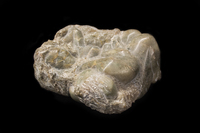Jane Botsford Armstrong
1967
Steatite
8 in. x 9 in. x 4 in.
Gift of Dr. James Rudel
Born in Buffalo, New York, Jane Botsford Armstrong (1921-2012) was always pushing boundaries. She was referred to as “a flower on the edge of the garden leaning out” by the headmistress at her school.1 Armstrong was adopted at a young age by a Mr. and Mrs. B. Botsford. She graduated from Pratt Institute and began teaching art in Vermont at the Northeast Kingdom. She ended up working as a journalist for the Journal of Commerce and later took on a position at the Burlington Free Press. A few years later Armstrong was hired in New York as one of three women given the honor to write articles on business in Chemical Week, the third largest magazine for McGraw Hill Publishers.2 This career path of journalism gave her the opportunity to travel. Armstrong worked under John Hovannes (1900-1973) and Jose de Creeft (1884-1982) when she enrolled in the Art Students League in New York.3 Hovannes was a sculptor as well as an educator, based out of New York City4 and de Creeft was known for his work with sculpture, particularly focusing on figural works of the female body.5 Both artists inspired Armstrong’s work with sculpture as she began to find her focal point in the medium. Armstrong found her passion in more abstract carved marble sculptures, often based on animals or the female form. Her most famous works are fossil-like marble sculptures of shells and other circular sea related creatures.6 Later on in life Armstrong’s eyesight began to deteriorate. This is when she switched mediums from stone to bronze most likely due to safety hazards with chipping of the stone. Examples of Armstrong’s work can be found in collections such as the Frank K. M. Rehn Gallery and the Burchfield Art Gallery.7
Her work in the collection of the College, Mother and Child, is a steatite sculpture in which it appears as if the mother and child are emerging from the depths of the stone. The mother and child seem as if they were created from within the stone and are only now emerging. This piece has subtle details and curvatures that highlight the mother’s positioning such as her arm behind her head and the child resting in her arms. Looking closely, we see that only particular parts of the bodies are showing such as the left arm and left breast of the mother. The most detailed area is within the mother’s face, which is emphasized even more by the hidden child’s face.
1. “Jane Armstrong,” Burchfield Penney Art Center. Accessed December 08, 2016. https://www.burchfieldpenney.org/artists/artist:jane-armstrong/.↩
2. Jill Burkett and Jeannette Landon, “Jane B. Armstrong’s Obituary,” Rutland Herald, November 27, 2012. Accessed November 25, 2016. http://www.legacy.com/obituaries/rutlandherald/obituary.aspx?pid=161271511↩
3. "Jane Armstrong,” Burchfield Penney Art Center.↩
4. "John Hovannes Papers,” Archives of American Art. Accessed December 1, 2016. https://www.aaa.si.edu/collections/john-hovannes-papers-7806↩
5. "Jose De Creeft (1884-1982),” Levis Fine Art. Accessed December 1, 2016. http://www.levisfineart.com/artists/jose-de-creeft-1884-1982.↩
6. Burkett and Landon, “Jane B. Armstrong’s Obituary on Rutland Herald.” ↩
7. Burkett and Landon, “Jane B. Armstrong’s Obituary on Rutland Herald.” ↩
-Haley Sieglein


